What is the primary role of potassium in the human body?
Bone formation
Blood clotting
Nerve function
Muscle contraction
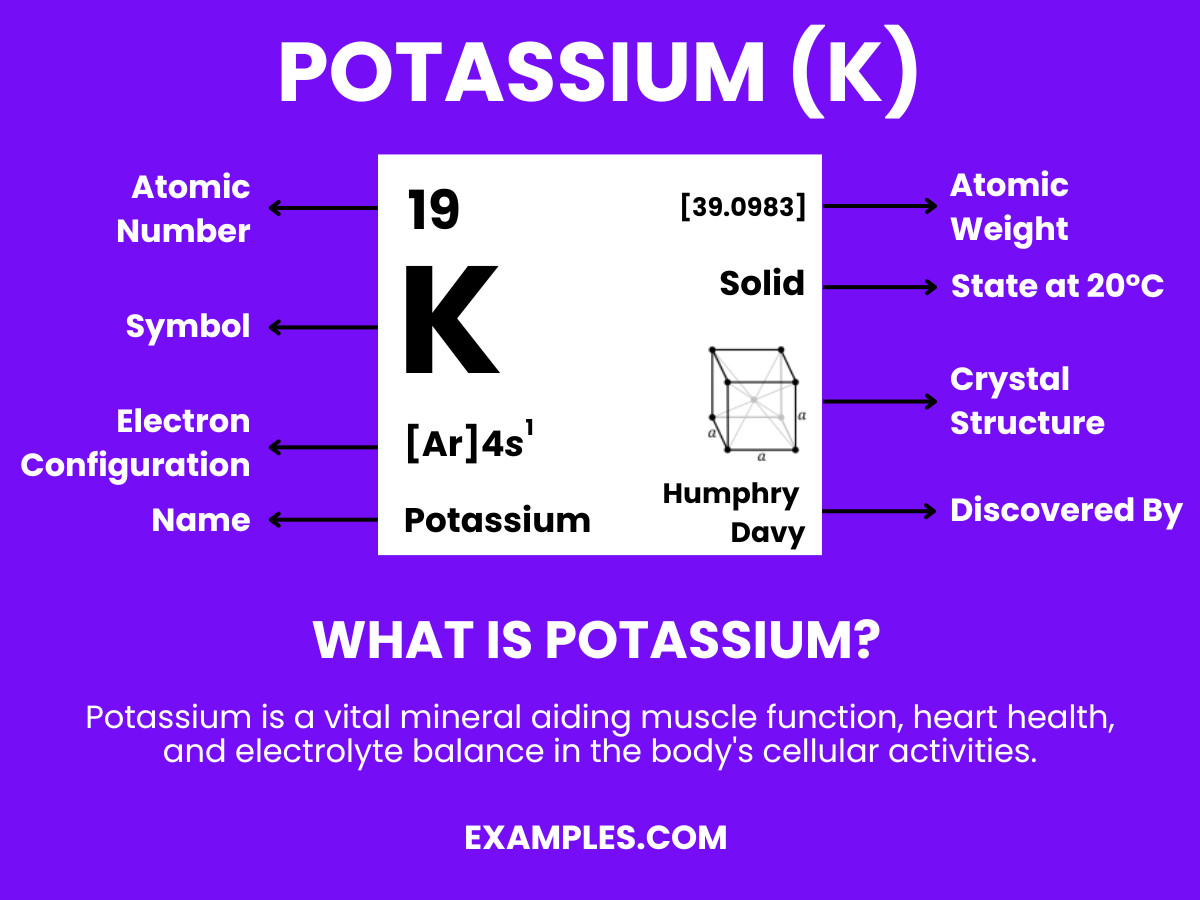
Potassium, an essential nutrient and a key alkali metal, plays a significant role in both biological processes and numerous industrial applications. This guide provides teachers with a thorough understanding of potassium’s properties, its importance in the human body, and its diverse uses in everyday life and technology. Enriched with examples, it’s designed to assist educators in making the concept of potassium engaging and accessible to students, enhancing their learning experience.
Potassium is a soft, silvery-white metal, classified as an alkali metal. It’s highly reactive, especially with water, and is essential for various biological functions in plants and animals, including humans. In nature, potassium is never found in its elemental form due to its high reactivity, but rather in compounds such as potassium chloride. Understanding its properties and uses is crucial in both the field of chemistry and in everyday life applications.
| Lithium |
| Sodium |
| Rubidium |
| Cesium |
| Francium |
Formula: K
Composition: A single potassium atom.
Bond Type: Highly reactive, especially with water.
Molecular Structure: Soft metal.
Electron Configuration: 19 electrons; configuration 1s² 2s² 2p⁶ 3s² 3p⁶ 4s¹.
Significance: Crucial for agriculture as a fertilizer component.
Role in Chemistry: Forms compounds like potassium nitrate (KNO₃), important in agriculture.
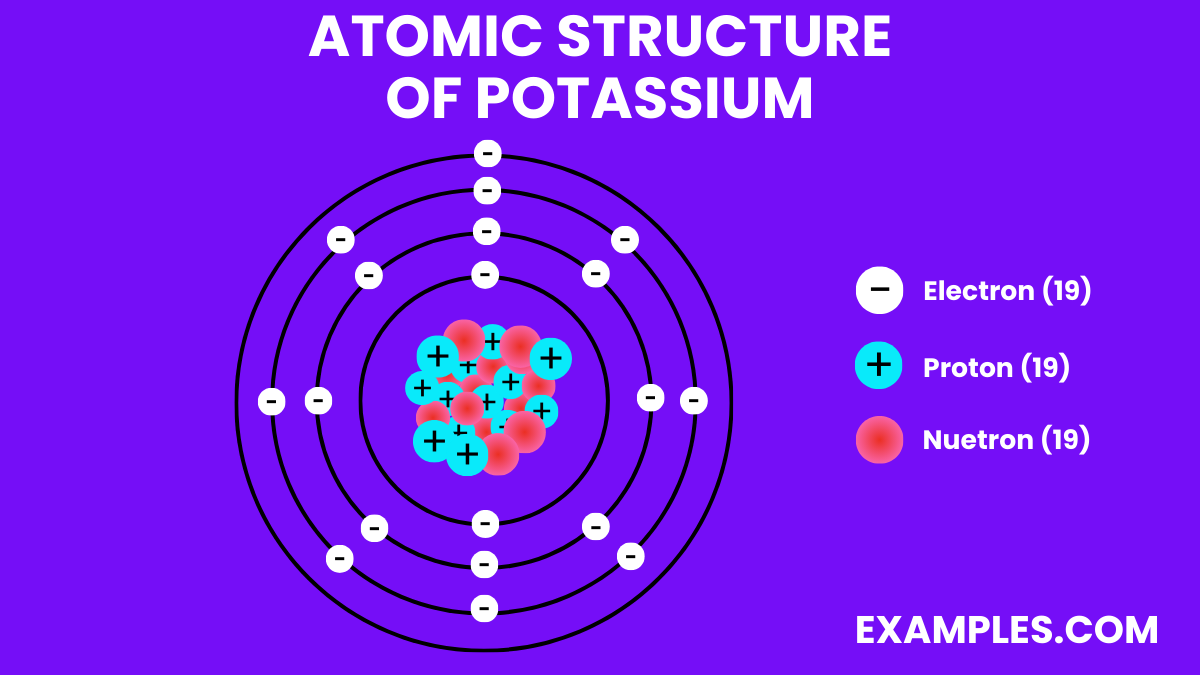
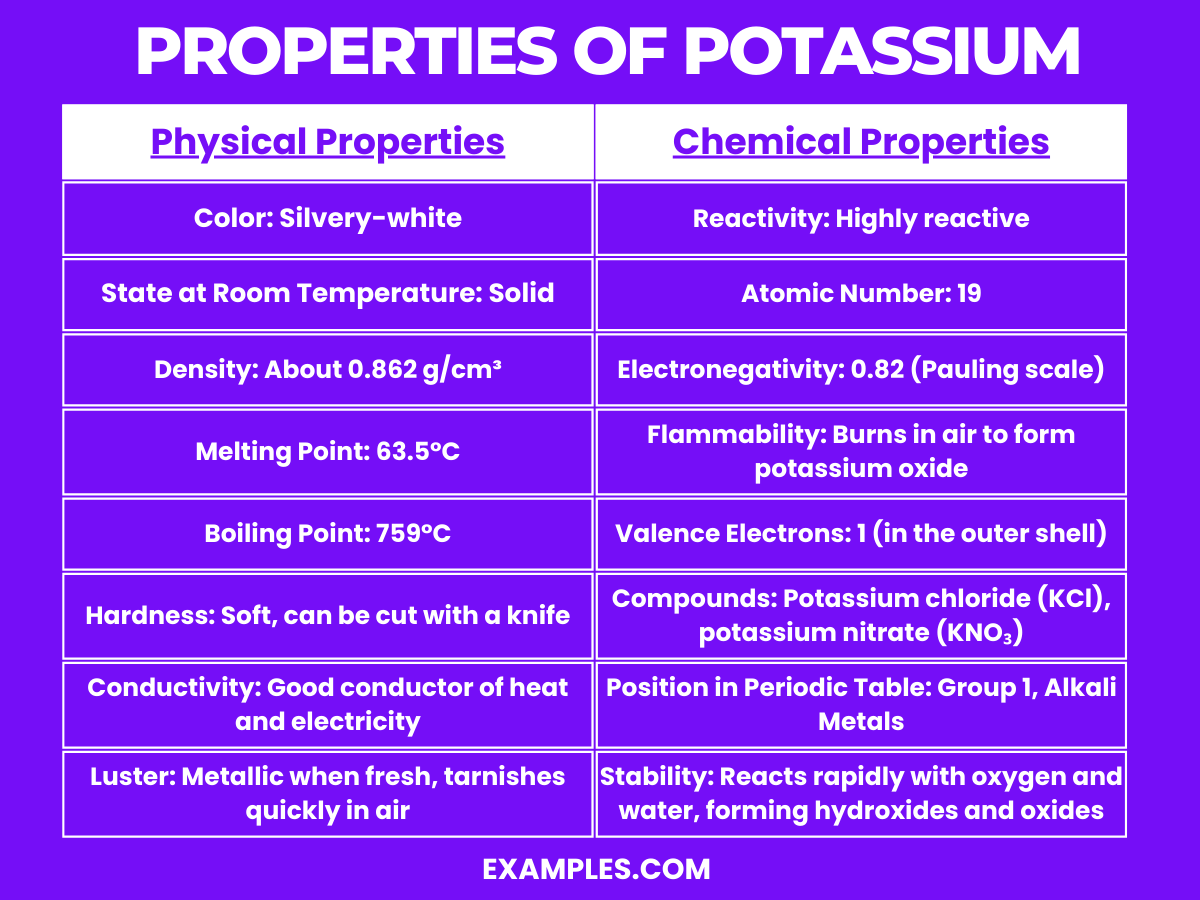
| Physical Property | Description |
|---|---|
| Color | Silvery-white |
| State at Room Temperature | Solid |
| Density | About 0.862 g/cm³ |
| Melting Point | 63.5°C (146.3°F) |
| Boiling Point | 759°C (1398°F) |
| Hardness | Soft, can be cut with a knife |
| Conductivity | Good conductor of heat and electricity |
| Luster | Metallic when fresh; tarnishes quickly in air due to oxidation |
Potassium, a member of the alkali metals, exhibits several distinctive chemical properties:
| Property | Value with Unit |
|---|---|
| Boiling Point | 759 °C |
| Melting Point | 63.5 °C |
| Critical Temperature | NA |
| Critical Pressure | NA |
| Heat of Vaporization | 76.9 kJ/mol |
| Heat of Fusion | 2.33 kJ/mol |
| Specific Heat Capacity (at 25°C) | 0.757 J/g·K |
| Thermal Conductivity | 102.5 W/m·K |
| Property | Value with Unit |
|---|---|
| Density (at 20°C) | 856 kg/m³ |
| Viscosity (at 63.5°C) | NA |
| Solubility in Water | Reacts vigorously with water |
| Color | Silvery |
| Phase at Room Temperature | Solid |
| Property | Value with Unit |
|---|---|
| Electrical Resistivity (at 20°C) | 7.2 µΩ·m |
| Thermal Conductivity | 102.5 W/m·K |
| Electronegativity (Pauling scale) | 0.82 |
| Ionization Energy | 4.3407 eV |
| Property | Value with Unit |
|---|---|
| Atomic Number | 19 |
| Atomic Mass | 39.0983 amu |
| Isotopes | ^39K (93.2581%), ^40K (0.0117%, radioactive), ^41K (6.7302%) |
| Nuclear Spin (for ^39K) | 3/2 ℏ |
| Nuclear Spin (for ^40K) | 4 ℏ |
| Nuclear Spin (for ^41K) | 3/2 ℏ |
| Neutron Cross Section (for ^39K) | 2.1 barns |
| Neutron Cross Section (for ^41K) | 1.46 barns |
| Nuclear Magnetic Moment (for ^39K) | 0.391 µN |
| Nuclear Magnetic Moment (for ^41K) | 0.214 µN |
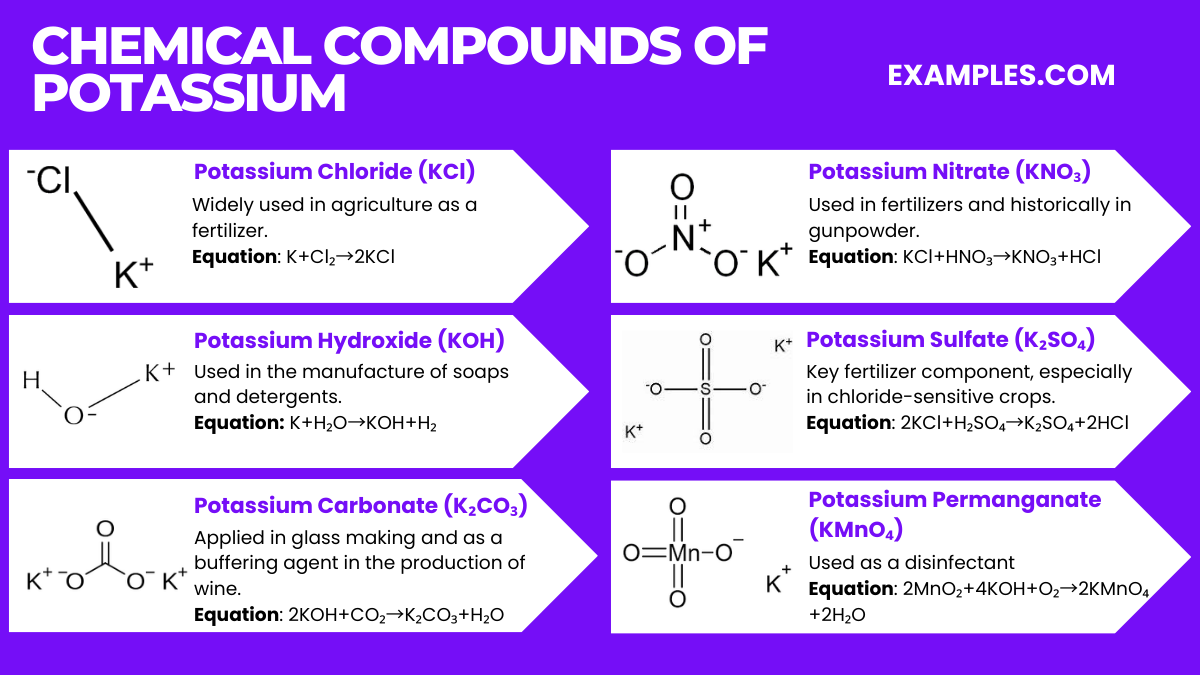
Potassium forms various compounds, each with unique applications. Here are six significant potassium compounds along with their chemical equations:
Potassium has several isotopes, each with specific properties. The table below provides an overview:
| Isotope | Mass Number | Natural Abundance (%) | Half-Life | Decay Mode |
|---|---|---|---|---|
| K-39 | 39 | 93.2581 | Stable | – |
| K-40 | 40 | 0.0117 | 1.248 x 10⁹ years | Beta decay, Electron capture |
| K-41 | 41 | 6.7302 | Stable | – |
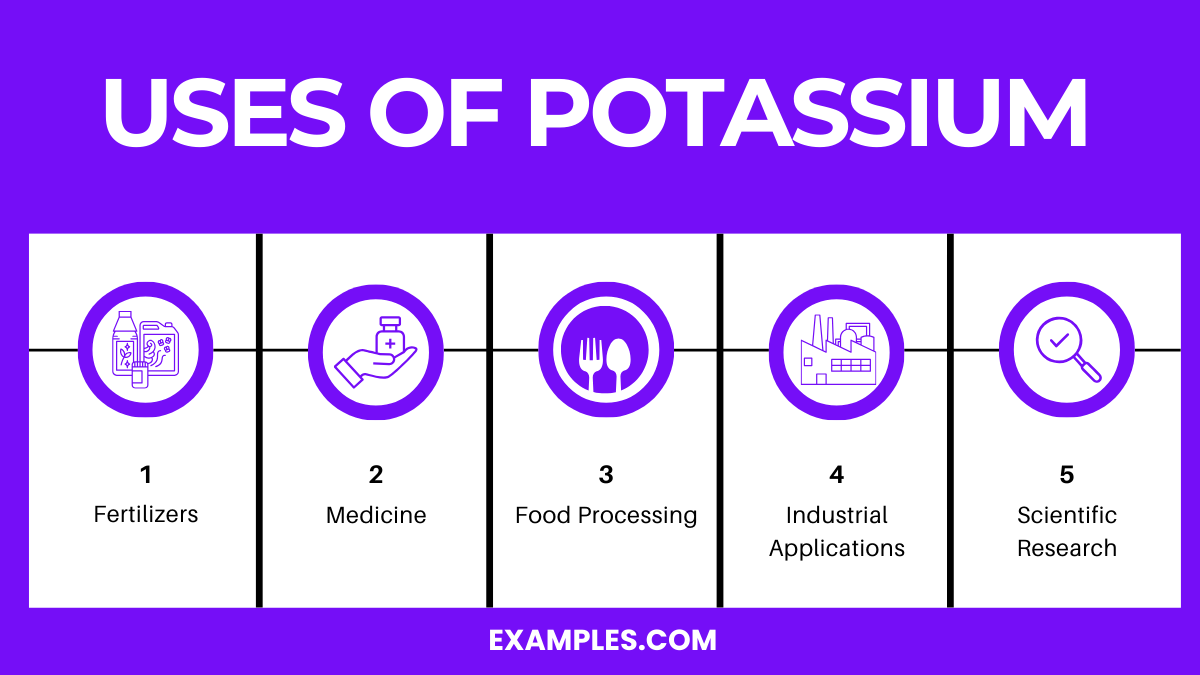
Potassium is a versatile element with several key applications:
The commercial production of potassium primarily involves the extraction of potassium salts from underground ore deposits and evaporite lakes:
Potassium, an essential mineral, plays several critical roles in human health:
The environmental impact of potassium is generally minimal compared to other elements:
Potassium regulates heart rhythm, muscle function, nerve signals, and fluid balance, and is vital for maintaining cardiovascular health and bone strength.
Low potassium levels, or hypokalemia, can cause muscle weakness, cramps, irregular heartbeats, fatigue, and in severe cases, life-threatening heart problems.
Excessively high potassium levels, known as hyperkalemia, can lead to dangerous heart rhythm disturbances, muscle weakness, and in extreme cases, cardiac arrest.
‘K’ is used for potassium based on its Latin name ‘Kalium’, reflecting historical naming conventions from the time of elemental discovery and classification.
Potassium is a crucial mineral, indispensable for numerous physiological functions in the human body. Its balanced levels are key to maintaining heart health, muscle function, and overall well-being. Understanding the importance of potassium, its health implications, and dietary sources is essential for educators to effectively convey its significance, promoting healthy lifestyle choices and awareness about this vital nutrient.

Potassium, an essential nutrient and a key alkali metal, plays a significant role in both biological processes and numerous industrial applications. This guide provides teachers with a thorough understanding of potassium’s properties, its importance in the human body, and its diverse uses in everyday life and technology. Enriched with examples, it’s designed to assist educators in making the concept of potassium engaging and accessible to students, enhancing their learning experience.
Potassium is a soft, silvery-white metal, classified as an alkali metal. It’s highly reactive, especially with water, and is essential for various biological functions in plants and animals, including humans. In nature, potassium is never found in its elemental form due to its high reactivity, but rather in compounds such as potassium chloride. Understanding its properties and uses is crucial in both the field of chemistry and in everyday life applications.
Formula: K
Composition: A single potassium atom.
Bond Type: Highly reactive, especially with water.
Molecular Structure: Soft metal.
Electron Configuration: 19 electrons; configuration 1s² 2s² 2p⁶ 3s² 3p⁶ 4s¹.
Significance: Crucial for agriculture as a fertilizer component.
Role in Chemistry: Forms compounds like potassium nitrate (KNO₃), important in agriculture.


Physical Property | Description |
|---|---|
Color | Silvery-white |
State at Room Temperature | Solid |
Density | About 0.862 g/cm³ |
Melting Point | 63.5°C (146.3°F) |
Boiling Point | 759°C (1398°F) |
Hardness | Soft, can be cut with a knife |
Conductivity | Good conductor of heat and electricity |
Luster | Metallic when fresh; tarnishes quickly in air due to oxidation |
Potassium, a member of the alkali metals, exhibits several distinctive chemical properties:
High Reactivity: Potassium is known for its high reactivity, especially with water. It reacts vigorously, producing potassium hydroxide and hydrogen gas.
Equation: 2K+2H₂O→2KOH+H₂
Atomic Number: Potassium has an atomic number of 19, indicating the presence of 19 protons in its nucleus.
Electronegativity: With an electronegativity of 0.82 on the Pauling scale, potassium tends to lose its single valence electron, forming ionic compounds.
Flammability: When exposed to air, especially if finely divided, potassium can ignite, burning to form potassium oxide.
Equation: 4K+O₂→2K₂O
Valence Electrons: Potassium has one electron in its outermost shell, making it highly reactive and prone to forming cations (K⁺).
Compound Formation: Potassium forms various important compounds, such as potassium chloride (KCl), potassium nitrate (KNO₃), and potassium carbonate (K₂CO₃).
Potassium Chloride: K+Cl₂→2KCl
Potassium Nitrate: KNO₃ (Used in fertilizers and gunpowder)
Potassium Carbonate: 2KOH+CO₂→K₂CO₃+H₂O
Position in Periodic Table: As a Group 1 element, potassium is among the alkali metals, characterized by their high reactivity and tendency to form +1 oxidation states.
Reaction with Oxygen: In the presence of oxygen, potassium forms oxides and peroxides.
Equation: 2K+O₂→K₂O₂ (Potassium Peroxide)
Property | Value with Unit |
|---|---|
Boiling Point | 759 °C |
Melting Point | 63.5 °C |
Critical Temperature | NA |
Critical Pressure | NA |
Heat of Vaporization | 76.9 kJ/mol |
Heat of Fusion | 2.33 kJ/mol |
Specific Heat Capacity (at 25°C) | 0.757 J/g·K |
Thermal Conductivity | 102.5 W/m·K |
Property | Value with Unit |
|---|---|
Density (at 20°C) | 856 kg/m³ |
Viscosity (at 63.5°C) | NA |
Solubility in Water | Reacts vigorously with water |
Color | Silvery |
Phase at Room Temperature | Solid |
Property | Value with Unit |
|---|---|
Electrical Resistivity (at 20°C) | 7.2 µΩ·m |
Thermal Conductivity | 102.5 W/m·K |
Electronegativity (Pauling scale) | 0.82 |
Ionization Energy | 4.3407 eV |
Property | Value with Unit |
|---|---|
Atomic Number | 19 |
Atomic Mass | 39.0983 amu |
Isotopes | ^39K (93.2581%), ^40K (0.0117%, radioactive), ^41K (6.7302%) |
Nuclear Spin (for ^39K) | 3/2 ℏ |
Nuclear Spin (for ^40K) | 4 ℏ |
Nuclear Spin (for ^41K) | 3/2 ℏ |
Neutron Cross Section (for ^39K) | 2.1 barns |
Neutron Cross Section (for ^41K) | 1.46 barns |
Nuclear Magnetic Moment (for ^39K) | 0.391 µN |
Nuclear Magnetic Moment (for ^41K) | 0.214 µN |

Potassium forms various compounds, each with unique applications. Here are six significant potassium compounds along with their chemical equations:
Potassium Chloride (KCl)
Equation: K+Cl₂→2KCl
Widely used in agriculture as a fertilizer.
Potassium Hydroxide (KOH)
Equation: K+H₂O→KOH+H₂
Used in the manufacture of soaps and detergents.
Potassium Carbonate (K₂CO₃)
Equation: 2KOH+CO₂→K₂CO₃+H₂O
Applied in glass making and as a buffering agent in the production of wine.
Potassium Nitrate (KNO₃)
Equation: KCl+HNO₃→KNO₃+HCl
Used in fertilizers and historically in gunpowder.
Potassium Sulfate (K₂SO₄)
Equation: 2KCl+H₂SO₄→K₂SO₄+2HCl
Another key fertilizer component, especially in chloride-sensitive crops.
Potassium Permanganate (KMnO₄)
Equation: 2MnO₂+4KOH+O₂→2KMnO₄+2H₂O
Used as a disinfectant and in water treatment.
Potassium has several isotopes, each with specific properties. The table below provides an overview:
Isotope | Mass Number | Natural Abundance (%) | Half-Life | Decay Mode |
|---|---|---|---|---|
K-39 | 39 | 93.2581 | Stable | – |
K-40 | 40 | 0.0117 | 1.248 x 10⁹ years | Beta decay, Electron capture |
K-41 | 41 | 6.7302 | Stable | – |
Potassium-40: Of particular note is Potassium-40 (K-40), a radioactive isotope that decays to Argon-40 and Calcium-40. It is used in potassium-argon dating, a method for dating ancient rocks. The presence of K-40 also means that all potassium naturally contains a very small amount of radioactivity.
Stable Isotopes: The majority of naturally occurring potassium is the stable isotopes K-39 and K-41.

Potassium is a versatile element with several key applications:
Fertilizers: The most significant use of potassium is in fertilizers, such as potassium chloride (KCl) and potassium sulfate (K₂SO₄). Potassium is vital for plant growth, improving disease resistance, water retention, and yield.
Medicine: Potassium compounds, especially potassium chloride, are used in medicine to treat and prevent low potassium levels in the blood, a condition known as hypokalemia.
Food Processing: Potassium salts like potassium nitrate (KNO₃) are used in food processing. They act as preservatives in products like meats and also aid in enhancing flavor and color.
Industrial Applications: Potassium hydroxide (KOH) is used in various industrial processes, including soap manufacturing, as a cleaning agent, and in the production of biodiesel.
Scientific Research: Potassium compounds are used in numerous scientific applications, including potassium-argon dating for determining the age of rocks and minerals. Potassium is also used in various types of research in chemistry and physics.
The commercial production of potassium primarily involves the extraction of potassium salts from underground ore deposits and evaporite lakes:
Mining: Potassium is mostly mined in the form of potash, which is potassium-bearing minerals such as sylvite (potassium chloride), carnallite, and langbeinite. These are extracted from underground mines using conventional mining methods.
Solution Mining: Another method for extracting potassium is solution mining. Water is injected into the ore deposit to dissolve the potassium salts, which are then brought to the surface in a brine solution. The potassium is then extracted from the brine.
Evaporation Ponds: In some regions, particularly where large salt lakes exist, potash can be obtained by evaporating water from the lake to leave behind potassium salts, which are then harvested.
Processing: After extraction, the raw potash is processed to remove impurities and then refined to produce various potassium compounds, such as potassium chloride and potassium sulfate, suitable for commercial use.
Environmental Considerations: The extraction and processing of potassium can have environmental impacts, including land disturbance from mining and water usage in solution mining. Efforts are made to mitigate these impacts through sustainable practices.
Potassium, an essential mineral, plays several critical roles in human health:
Cardiovascular Health: Potassium is vital for maintaining a healthy heart. It helps regulate heart rhythm and reduces the risk of high blood pressure and strokes by counteracting the effects of sodium.
Muscle Function: It aids in muscle contraction, including the smooth muscles in blood vessels, thereby impacting blood pressure regulation. Potassium is also crucial for normal skeletal muscle function.
Nervous System Function: Potassium assists in nerve function by helping transmit nerve signals throughout the body, essential for various body functions including reflexes and muscle coordination.
Fluid Balance: It plays a key role in maintaining fluid balance in the body, working in concert with sodium to regulate the balance of fluids and electrolytes.
Bone Health: Adequate potassium intake is associated with improved bone health. It may help to neutralize bone-depleting metabolic acids, thereby preserving calcium in bones.
Deficiency and Overdose: Potassium deficiency, known as hypokalemia, can lead to fatigue, muscle cramps, and irregular heartbeats. Conversely, too much potassium, or hyperkalemia, is harmful especially for people with kidney disorders, as it can lead to cardiac arrest.
Dietary Sources: Common dietary sources of potassium include fruits (like bananas and oranges), vegetables, whole grains, milk, meat, and nuts.
The environmental impact of potassium is generally minimal compared to other elements:
Soil Health: Potassium is a critical nutrient for plant growth. Its presence in soil is essential for the healthy growth of plants and it is a key component of fertilizers.
Water Systems: Excessive use of potassium-based fertilizers can lead to runoff into water systems, potentially causing nutrient pollution in lakes and rivers. This can lead to eutrophication, a process that can deplete oxygen in water bodies and harm aquatic life.
Mining Impact: The mining of potassium, especially for potash, can have environmental impacts such as habitat destruction, groundwater contamination, and air pollution.
Ecosystem Balance: In natural ecosystems, potassium occurs in balanced concentrations and is recycled through natural processes. Human activities, mainly through agriculture and mining, can disrupt this balance.
Sustainability Practices: Efforts are made in the potassium industry to minimize environmental impacts, including improved mining techniques, better waste management, and controlled use of potassium-based fertilizers.
Potassium regulates heart rhythm, muscle function, nerve signals, and fluid balance, and is vital for maintaining cardiovascular health and bone strength.
Low potassium levels, or hypokalemia, can cause muscle weakness, cramps, irregular heartbeats, fatigue, and in severe cases, life-threatening heart problems.
Excessively high potassium levels, known as hyperkalemia, can lead to dangerous heart rhythm disturbances, muscle weakness, and in extreme cases, cardiac arrest.
‘K’ is used for potassium based on its Latin name ‘Kalium’, reflecting historical naming conventions from the time of elemental discovery and classification.
Potassium is a crucial mineral, indispensable for numerous physiological functions in the human body. Its balanced levels are key to maintaining heart health, muscle function, and overall well-being. Understanding the importance of potassium, its health implications, and dietary sources is essential for educators to effectively convey its significance, promoting healthy lifestyle choices and awareness about this vital nutrient.
Text prompt
Add Tone
10 Examples of Public speaking
20 Examples of Gas lighting
Electrons
Neutrons
Protons
What is the primary role of potassium in the human body?
Bone formation
Blood clotting
Nerve function
Muscle contraction
Which food is a rich source of potassium?
Beef
Rice
Bananas
Bread
What is a common effect of potassium deficiency?
Hypertension
Increased cholesterol
Muscle cramps
Insomnia
How does potassium benefit plant health?
Enhances flower color
Increases seed production
Improves root growth
Helps in water retention
Which industrial process uses potassium?
Steel manufacturing
Glass production
Fertilizer creation
Textile dyeing
What is the effect of high potassium intake on heart health?
Reduces heart rate
Increases blood pressure
Lowers blood pressure
Causes arrhythmia
In what form is potassium most commonly found in nature?
Elemental potassium
Potassium salts
Potassium gases
Potassium liquids
What is a significant risk associated with high levels of potassium?
Anemia
Hyperkalemia
Osteoporosis
Hyperglycemia
How does potassium affect the body’s fluid balance?
Decreases water absorption
Increases dehydration
Regulates fluid levels
Has no effect
Which organ is primarily responsible for regulating potassium levels in the body?
Liver
Heart
Kidneys
Lungs
Before you leave, take our quick quiz to enhance your learning!

